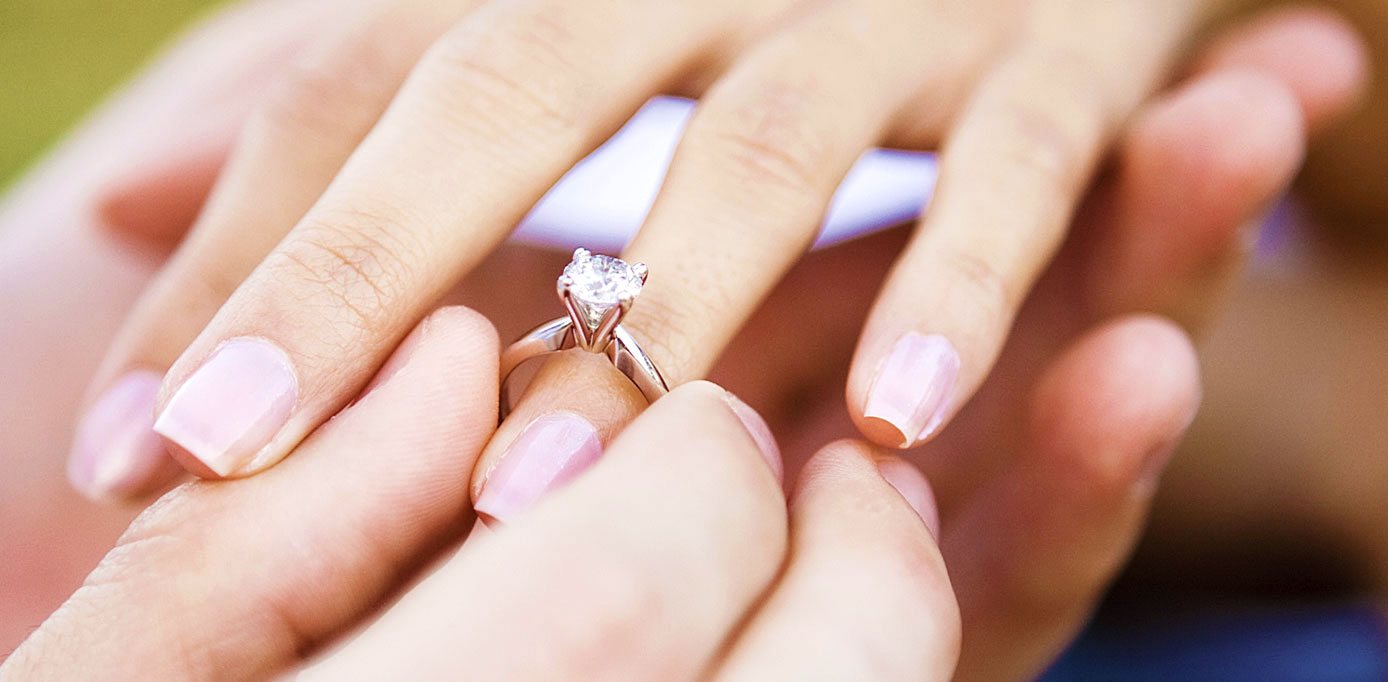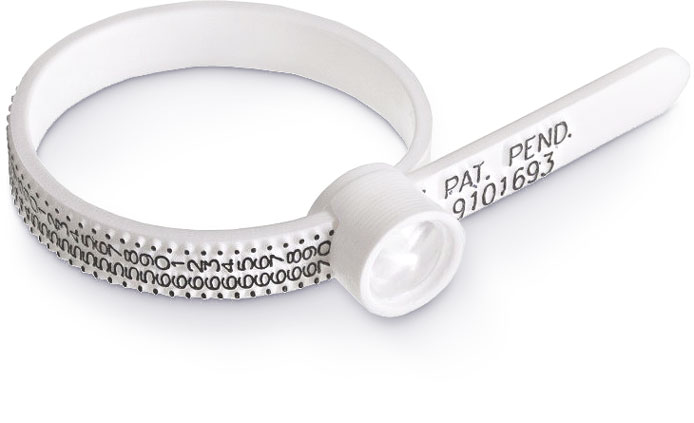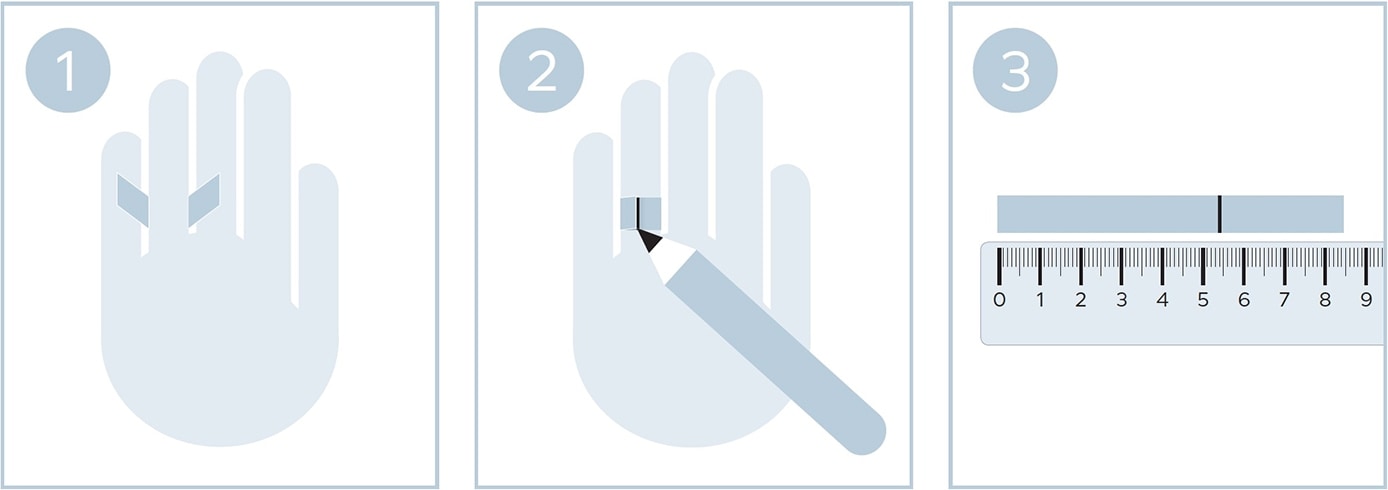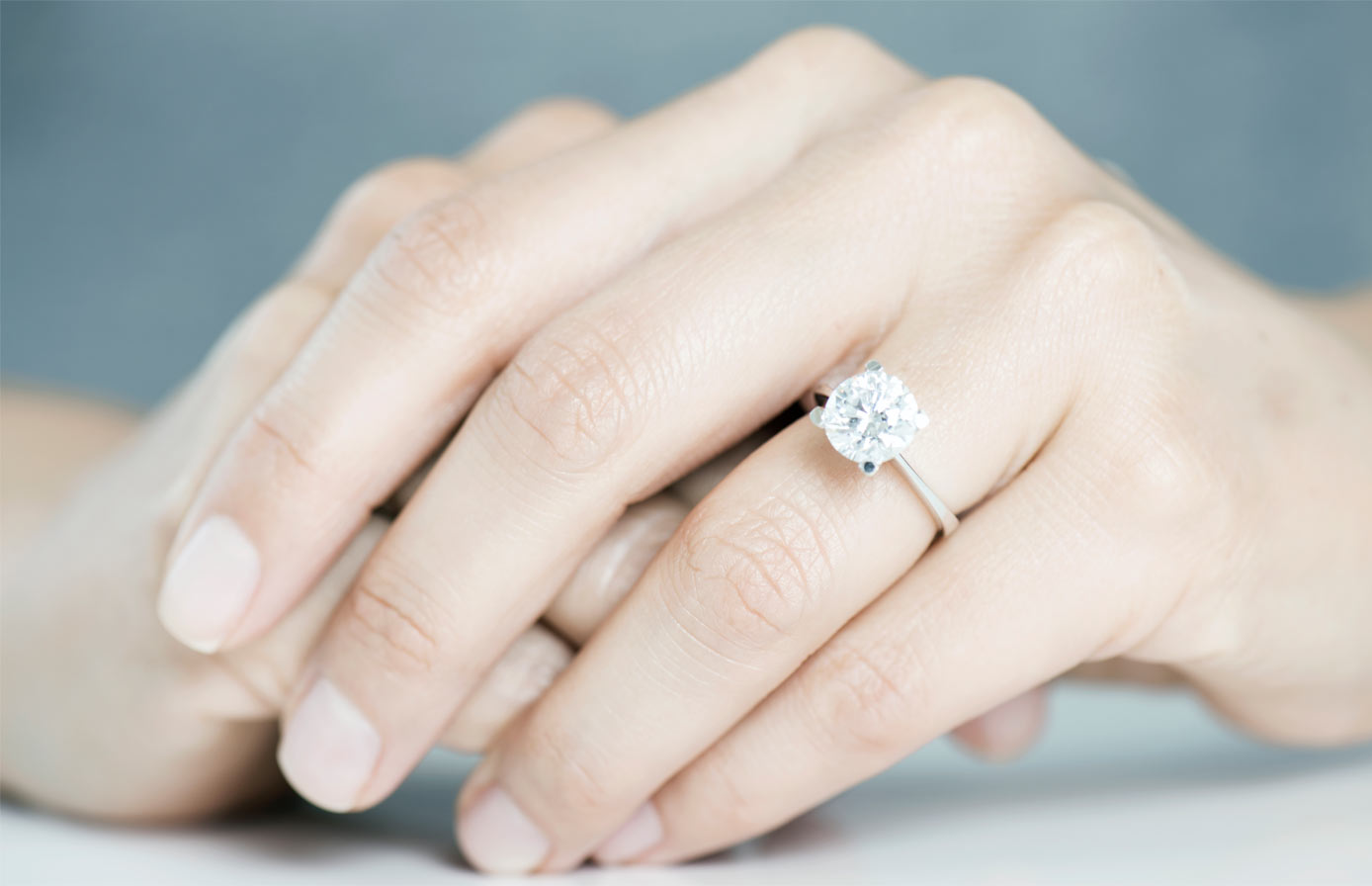

Work out the right ring size - no problem! Measure and work out the ring size - there are 3 methods:
Measuring with a ring template can be carried out very quickly and is ideal if you want to secretly work out the ring size.
For the second method with the ring tape measure you need the help of your partner. This is useful if the engagement ring you received does not fit.
The third method also uses a paper strip to measure the finger.
Work out the ring size? Already done!
If the inner diameter or an internationally used ring size is already known, our ring size table helps with the conversion.
Here you can download the ring size template (PDF, 31 KB), measure the inner diameter and work out the correct ring size.
Using the ring size template is very simple: Take - of course as inconspicuously as possible - a ring that your partner often wears, print the template according to instructions and compare the ring with the information on the template. Done.
If your partner already knows about the engagement, simply call us and order the free ring tape measure, so you can easily work out the right ring size by measuring your partners finger.
The measuring tape works in a similar way to a belt and is very easy to use. When the ring tape measure is conveniently placed on your partner's ring finger, you can read the correct size of the inside diameter in the viewing window.

The most frequently bought ring size for women is 54 - after all, over 80% of all women have sizes between 48 and 56.
Work out the correct ring size without a ring? We have a simple method. All you need is a pen, a strip of paper and a ruler.
Preparations
First cut an 8 - 10 cm long, maximum 1 cm wide strip from a sheet of paper.

Example: A length of 5.4 cm corresponds to ring size 54.
Perform control measurements to compensate for measurement fluctuations. Repeat steps 1 - 3 a few times and then work out the mean value of your measurements.


The thickness of our fingers varies throughout the day and at changing temperatures. In the morning the finger is thinner than in the evening; in winter and in a cold environment it is thinner than in the summer.
Also, in the course of the years and with pregnancy the circumference of the finger changes. The left and right ring fingers usually have different circumferences. And the phalanges is the widest part of the ring finger for most women.
Therefore, we recommend taking the measurements shortly before you order and - if possible - measure several times at different times of the day. This will give you a feeling for the circumference of the finger, which is crucial for a ring that's comfortable to wear.
The fingers of the left and right hand have a different thickness. What sounds trivial at first turns out to be a problem if the ring does not fit. Before the first measurement, work out which finger and which hand the ring will be worn on. Engagement rings, for example, are usually worn on the ring finger of the left hand.
Important: The circumference of the finger must be measured in the right place. Normally, rings are pushed over the second phalanx of the finger (the so-called middle phalanx or phalanx media). They then sit in the middle between the second and third phalanx, the phalanx proximalis.
Exceptions are thumb rings or if very many rings are worn on one finger.
In order to determine the appropriate ring size, we have carried out and recorded five measurements over several days in this practical example. The first at noon, the finger circumference was 53.5 mm, the second in the evening at medium temperature. The finger already had a little more circumference at this time.
The third measurement took place early in the morning after getting up and led to the result with the smallest finger circumference (53 mm). The fourth measurement was made on a warm summer evening and the fifth on the following day at noon.
To determine the mean finger circumference, add all the measurement results and divide this value by the number of measurements.
53,5 + 54 + 53 + 54,5 + 54
= 269 ÷ 5 measures
= 53,8 → rounded: 54 mm
The result of our measurement: the median finger circumference corresponds to 54 mm, thus the suitable ring size is 54.
We sell and adjust many rings and can therefore tell you exactly which sizes are most in demand. The most common ring size for women's rings is 54. More than 80% of all women's hands fit ring sizes between 48 and 56. The majority of men wear rings in sizes 57 to 62.
If you do not have any further information, please select a size within these ranges. If you think partner's finger has a bigger circumference, choose a size in the upper range up to 56. If your sweetheart has rather small fingers, a size of 52 and below will most likely fit.
Simply use our international ring size table to find out the size on the basis of the inner diameter (∅ mm). The conversion table for rings takes into account the dimensions valid in our country of origin Germany. The German ring gauge matches the inner circumference of the ring in millimeters.
The table below shows the different dimensions of American and Canadian (USA/CAN), English (UK), French and European (FRA/EU) or Japanese (JPN) sizes and makes it easy to convert between them.
| ∅ mm | GER | EU/FRA | ENG | USA/CAN | JPN |
|---|---|---|---|---|---|
| 12,7 | 40 | 0 | C | 1.4 (1) | 0,2 |
| 13,0 | 41 | 1 | C 1/2 | 1.8 (1-) | 1,1 |
| 13,3 | 42 | 2 | D 1/2 | 2.2 (2) | 2,1 |
| 13,7 | 43 | 3 | E 1/2 | 2.6 (2-) | 3,1 |
| 14,0 | 44 | 4 | F | 3.0 (2-) | 4,0 |
| 14,3 | 45 | 5 | G | 3.4 (3) | 5,0 |
| 14,6 | 46 | 6 | G 1/2 | 3.7 (3-) | 5,9 |
| 14,9 | 47 | 7 | H 1/2 | 4.1 (4) | 6,9 |
| 15,3 | 48 | 8 | I 1/2 | 4.5 (4-) | 7,8 |
| 15,6 | 49 | 9 | J | 4.9 (4-) | 8,8 |
| 15,9 | 50 | 10 | K | 5.3 (5) | 9,7 |
| 16,3 | 51 | 11 | K 1/2 | 5.7 (5-) | 10,7 |
| 16,6 | 52 | 12 | L 1/2 | 6.1 (6) | 11,6 |
| 16,9 | 53 | 13 | M 1/2 | 6.4 (6) | 12,6 |
| 17,2 | 54 | 14 | N | 6.8 (6-) | 13,6 |
| 17,5 | 55 | 15 | O | 7.2 (7) | 14,5 |
| 17,8 | 56 | 16 | P | 7.6 (7-) | 15,5 |
| 18,2 | 57 | 17 | P 1/2 | 8.0 (7-) | 16,4 |
| 18,5 | 58 | 18 | Q 1/2 | 8.4 (8) | 17,4 |
| 18,8 | 59 | 19 | R | 8.7 (8-) | 18,3 |
| 19,1 | 60 | 20 | S | 9.1 (9) | 19,3 |
| 19,4 | 61 | 21 | T | 9.5 (9-) | 20,2 |
| 19,7 | 62 | 22 | T 1/2 | 9.9 (9-) | 21,2 |
| 20,1 | 63 | 23 | U 1/2 | 10.3 (10) | 22,2 |
| 20,4 | 64 | 24 | V | 10.7 (10-) | 23,1 |
| 20,7 | 65 | 25 | W | 11.0 (11) | 24,1 |
| 21,0 | 66 | 26 | X | 11.4 (11) | 25,0 |
| 21,3 | 67 | 27 | X 1/2 | 11.8 (11-) | 26,0 |
| 21,6 | 68 | 28 | Y 1/2 | 12.2 (12) | 26,9 |
| 22,0 | 69 | 29 | Z 1/2 | 12.6 (12-) | 27,9 |
| 22,3 | 70 | 30 | Z +1 | 13.0 (12-) | 28,8 |
Save and take with you: The ring size table as a free PDF (61 KB).
We want you to be completely satisfied with the piece of jewellery you have purchased from us. If you have accidentally ordered a ring in the wrong size, this is no problem. One of our services is to change the ring size (for non-engraved rings) free of charge. We also cover the costs of the return for you. All you have to do is work out the right ring size, and we will do the rest!
The free shipping process is very easy using our return portal.
Note: Once we have received your piece of jewellery, we will need approximately 3-5 business days to re-size the ring. If you wish to change the ring size by more than 4 ring sizes or if the ring is already engraved, the processing can take up to 7 working days.
As engraved rings usually cannot be changed, we charge a handling fee of €35 for changing the size of engraved rings.